As an Amazon Associate I earn from qualifying purchases. This website also participates in other affiliate programs and may earn commissions if you shop through the links used on this website.
(This article was originally published on September 30, 2022 and was last updated on June 23, 2023)
When summer hits, we can’t get enough basil. From pizza to pesto to a perfect tomato sauce, a fresh supply of basil throughout the year is the stuff that dreams are made of.
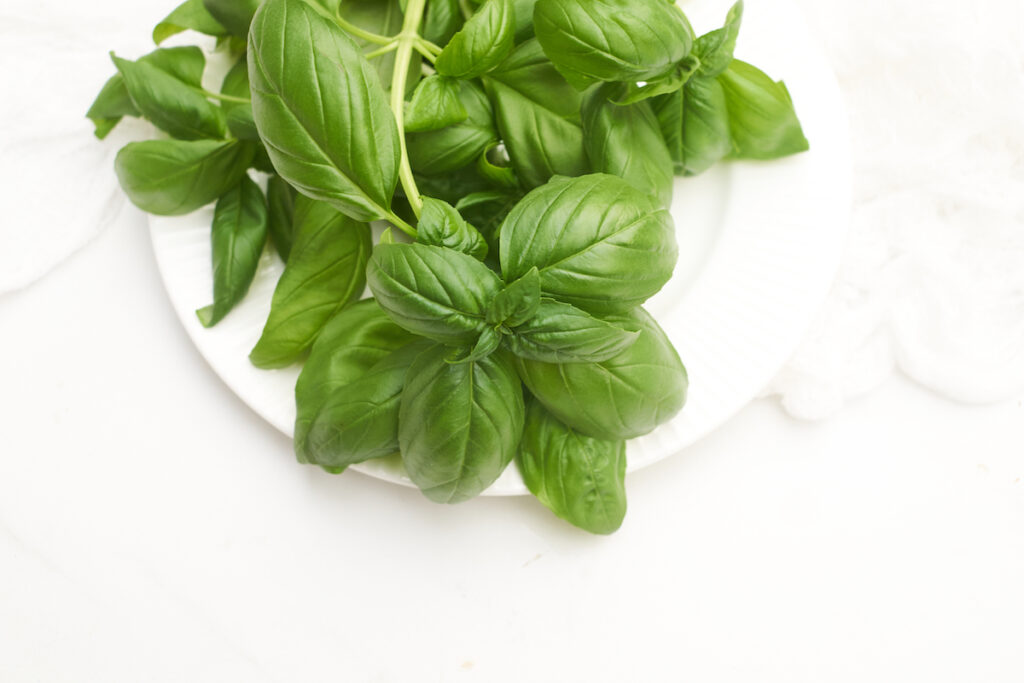
Unfortunately, basil isn’t naturally a “year round” plant. Rather, it’s a perennial plant that thrives in the warmth of summer, and then flowers and goes to seed before winter hits (and it dies).
If you don’t plan on moving your basil plant indoors for winter, you’ll have to make a choice: let it go to seed, or harvest it all and preserve the fresh leaves, either by drying them or freezing them.
Freezing basil is pretty easy, and will keep for months. And depending on your end goals, there are a few different freezing methods you can try to enjoy your summer harvest of basil, all year long (straight from your freezer).
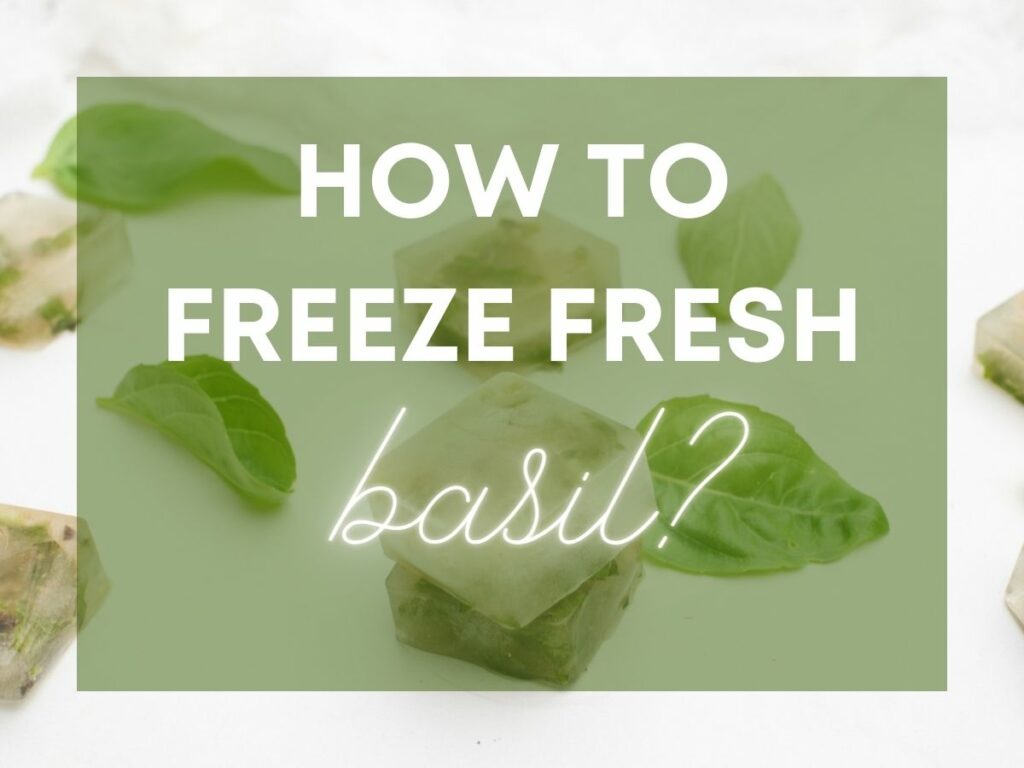
Table of Contents
Tips for Freezing Getting the Best Quality Frozen Basil
Before freezing your basil harvest, make sure you know how to get the most out of your end of summer harvest, by choosing the right leaves, tools, and method for your needs.
Preparing Basil for Freezing
- Start with good, healthy basil leaves that are free from obvious signs of stress or disease. This means no wilting, yellowing, brown edges, black spots, white stuff growing, holes, etc.
- Prune off the basil leaves you want to freeze, and remove the leaves from the stems.
- Gently wash the basil leaves, handling carefully to avoid bruising as much as possible.
- Dry the basil leaves to get as much moisture off them as possible. A salad spinner works great for this step, as well as patting dry with paper towel or a lint free cloth.
Use the Right Tools, If Possible
- A salad spinner is a great tool when washing and drying basil. It helps get the moisture off the basil leaves before freezing, and without bruising the leaves too much. Excess moisture on the leaves will increase the chances of freezer burn, but also means you’re more likely to experience discoloration when freezing, losing the beautiful bright green color of the basil.
- If you’re freezing in ice cube trays, try to use silicone trays. They make it way easier to pop the cubes out once frozen when compared to plastic. You can also use an herb freezing tray, which is specifically made for this purpose.
- If you don’t have an ice cube tray, or you’ve filled up all your ice cube trays but still have some basil and oil or pesto to freeze, you can simply scoop them onto a silimat or parchment-lined baking tray, in little mounds like cookie dough. The result isn’t as beautiful as the perfect cubes of an ice cube tray, but it still works!
- Make sure you have enough freezer bags or airtight containers on hand for the amount of basil you have to freeze. Use a Sharpie or other permanent marker to label the container with the date frozen, and what’s inside the bag (i.e. flash frozen whole basil leaves or basil in olive oil cubes, etc.).
- Try to get as much air out of the freezer bag as possible when storing. This will maximize freshness.
6 Ideas for Freezing Your Fresh Basil Leaves
Below, I’ve gone over 6 different methods for freezing your fresh basil leaves, including methods that require blanching and those that don’t, and methods that freeze basil in olive oil, and those that don’t. I
n my opinion, there are some clear winners and losers among these methods. I personally am not a fan of blanching, because of how fussy it is, and how easy it is to get it wrong and end up with blackened basil leaves, which just don’t look as appetizing as bright green ones!
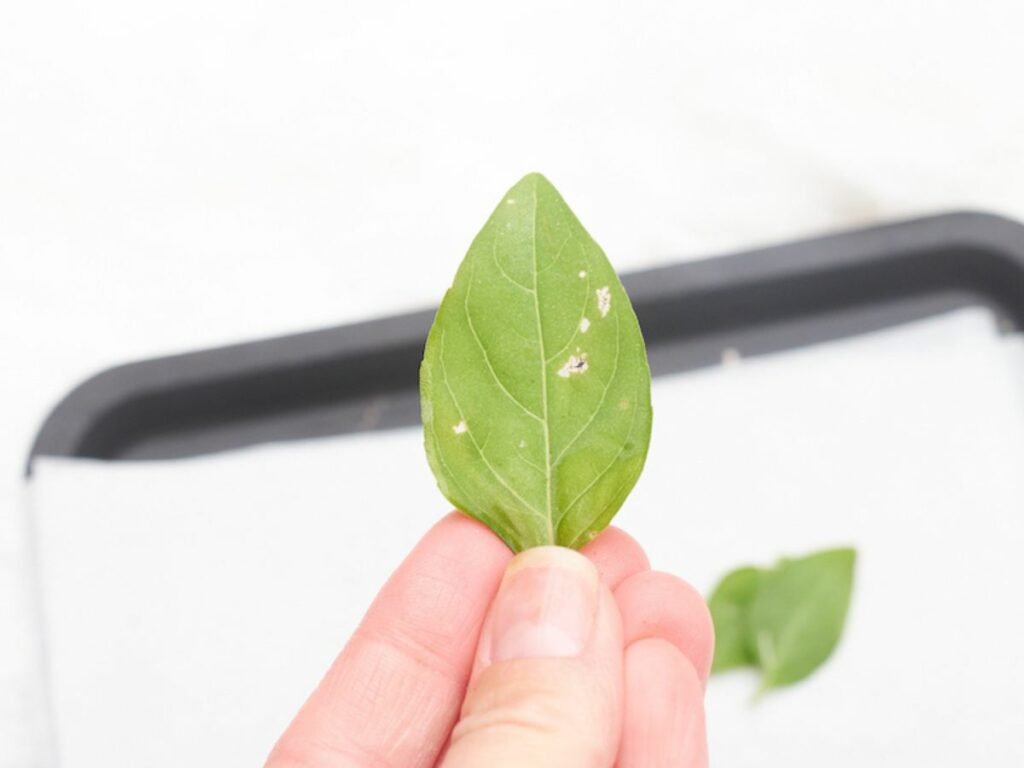
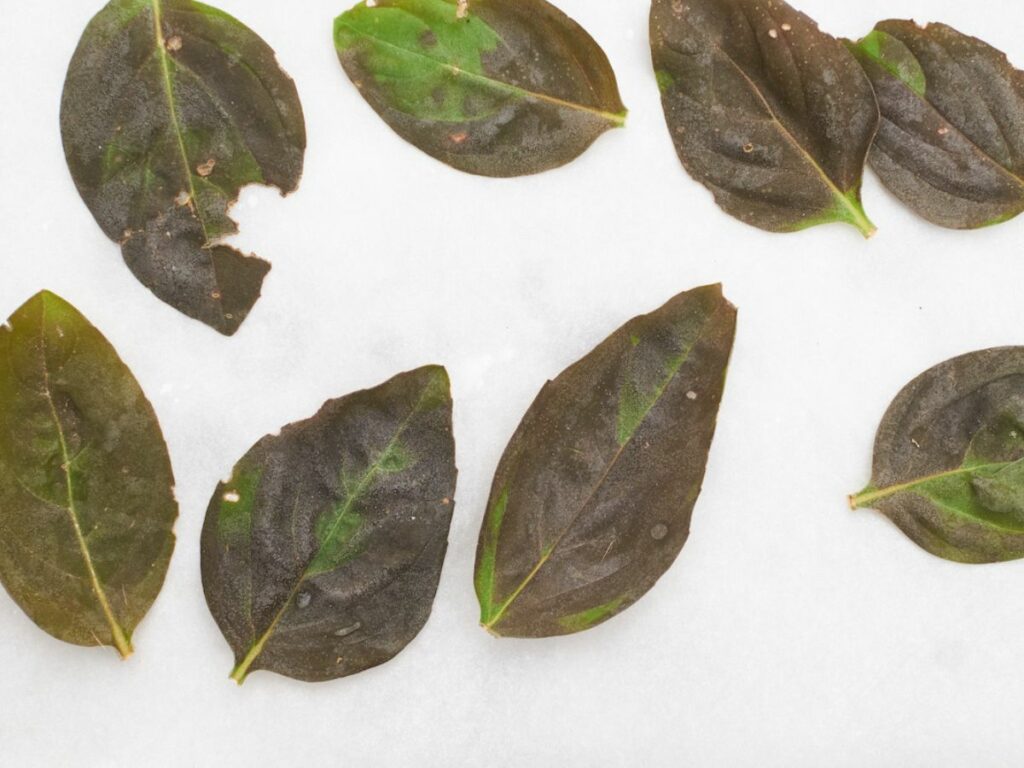
Method 1: Freeze Basil in Olive Oil
Freezing basil in olive oil is easy and practical, and helps preserve flavor and color. Add the cubes to the skillet or saucepan when cooking, towards the end. The basil cube will melt, giving your meal a burst of fresh basil flavor all year long!
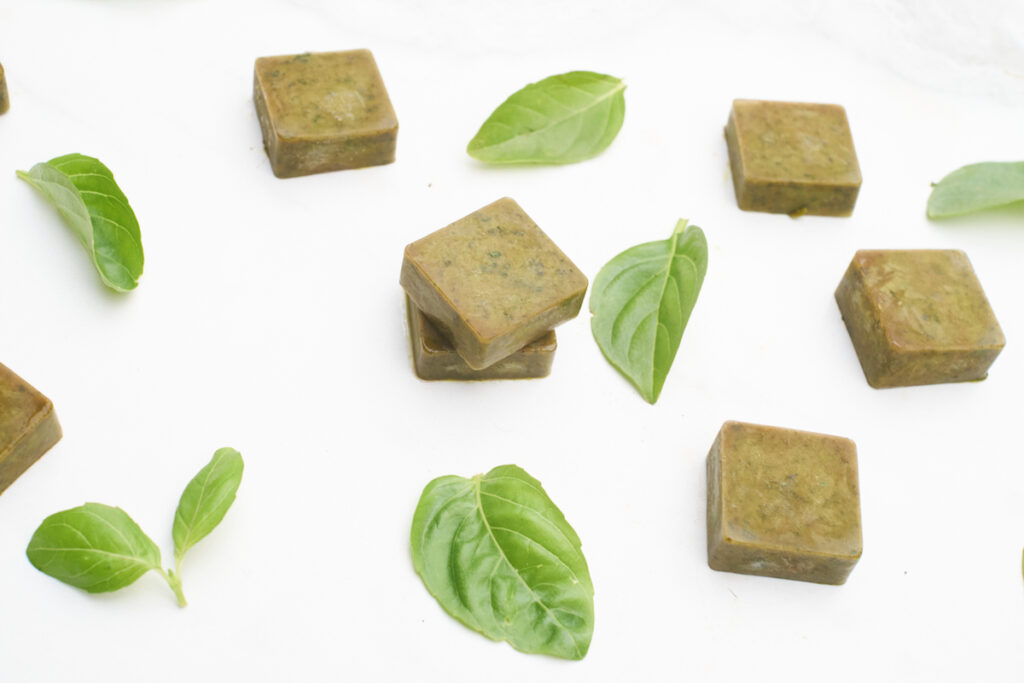
The TLDR of this method is you put the clean, dry basil leaves in a food processor with olive oil, blend it all up, and then freeze the mixture in an ice cube tray.
I used a food processor for this method, but if you don’t have one, or don’t want to use it for whatever reason, you can also rough chop the basil for this method, and hand mix the rough chopped basil with olive oil.
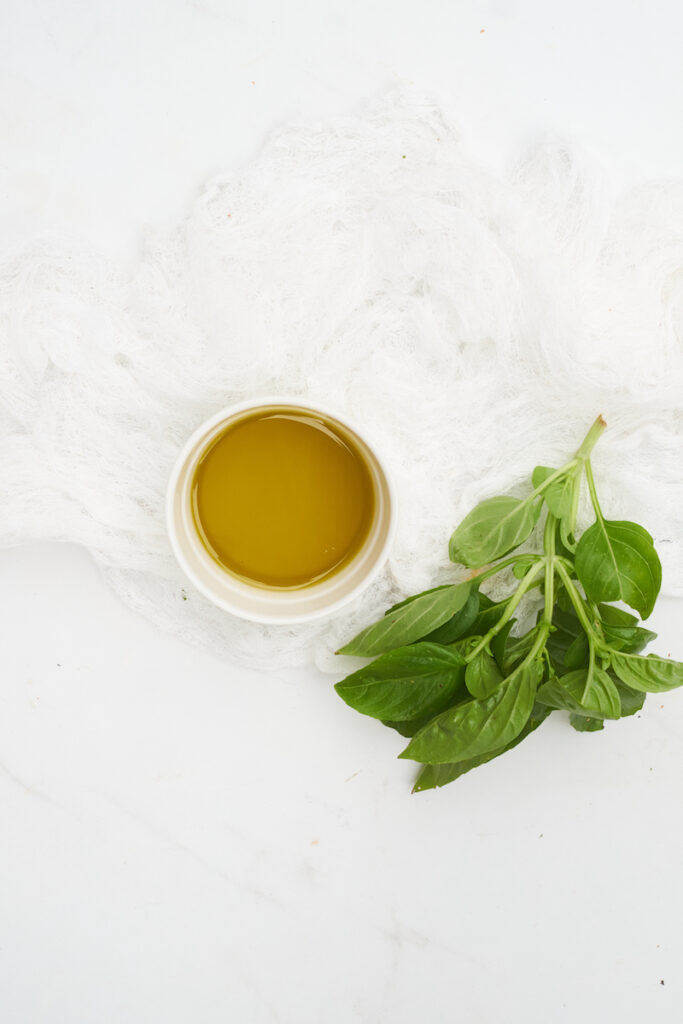
The trick is to find the right amount of olive oil. You want enough to coat the basil leaves (which will preserve them and prevent discoloration in the freezer), but not too much that it overpowers your cooking when it comes time to use them.
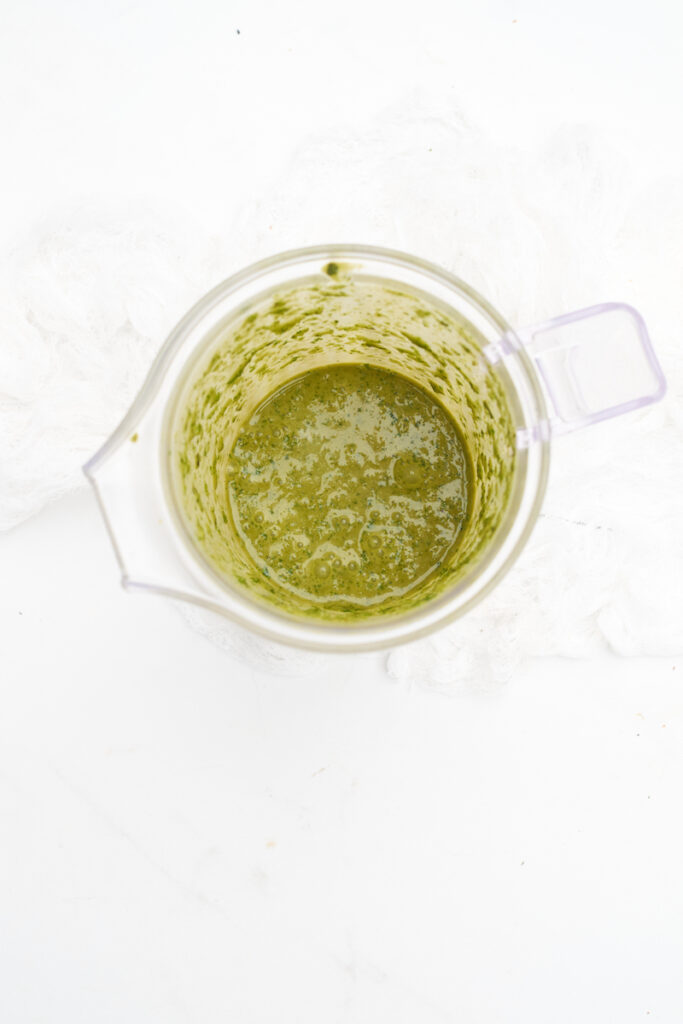
I usually start with about 2 tablespoons and add more if needed.
Once the basil is puréed and coated with oil, pour the mixture into ice cube trays and freeze.
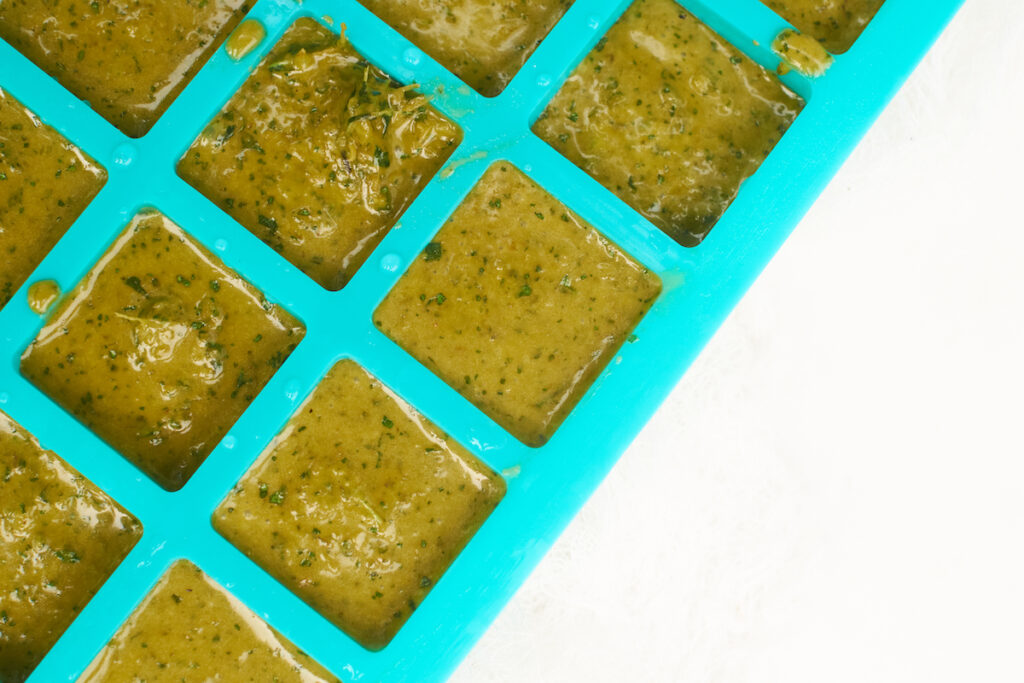
Once they’re completely frozen (at least a few hours, but I usually leave mine for 24 hours) you can pop them out of the ice cube tray and store them in a ziplock freezer bag, or another airtight container.

Method 2 – Freeze Basil Chiffonade in Broth
Freezing basil chiffonade in broth is a great way to preserve fresh basil for use in soups, pasta sauces, or a stir fry – basically, when you want some basil, but don’t want the extra oil from Method 1 (basil and olive oil cubes).
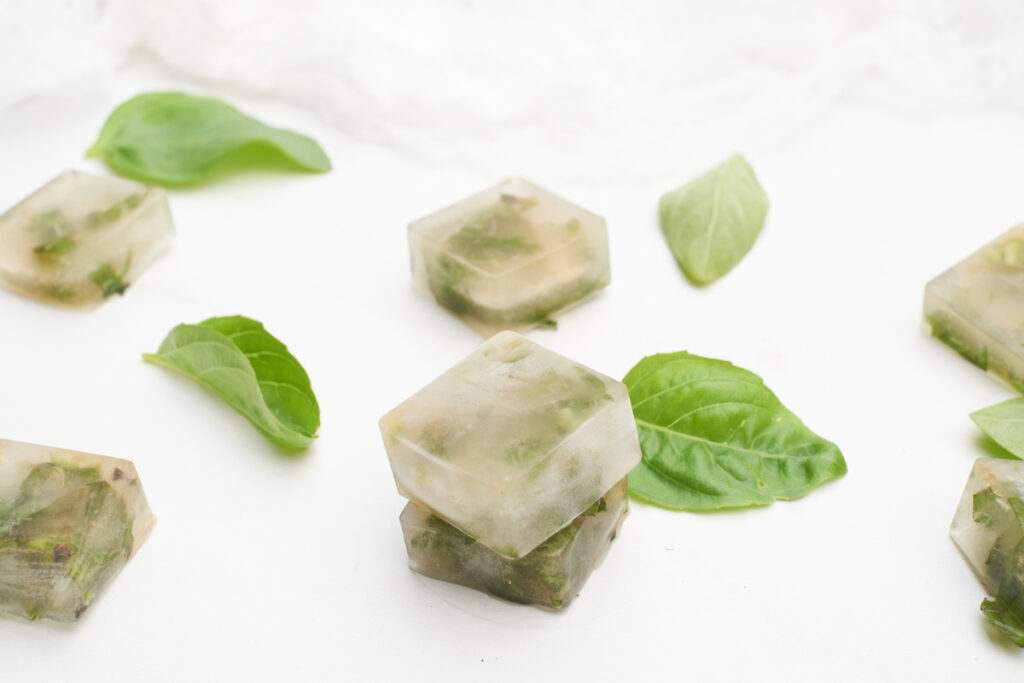
This method uses basil chiffonade. Chiffonade is a cutting technique that creates delicate basil ribbons.
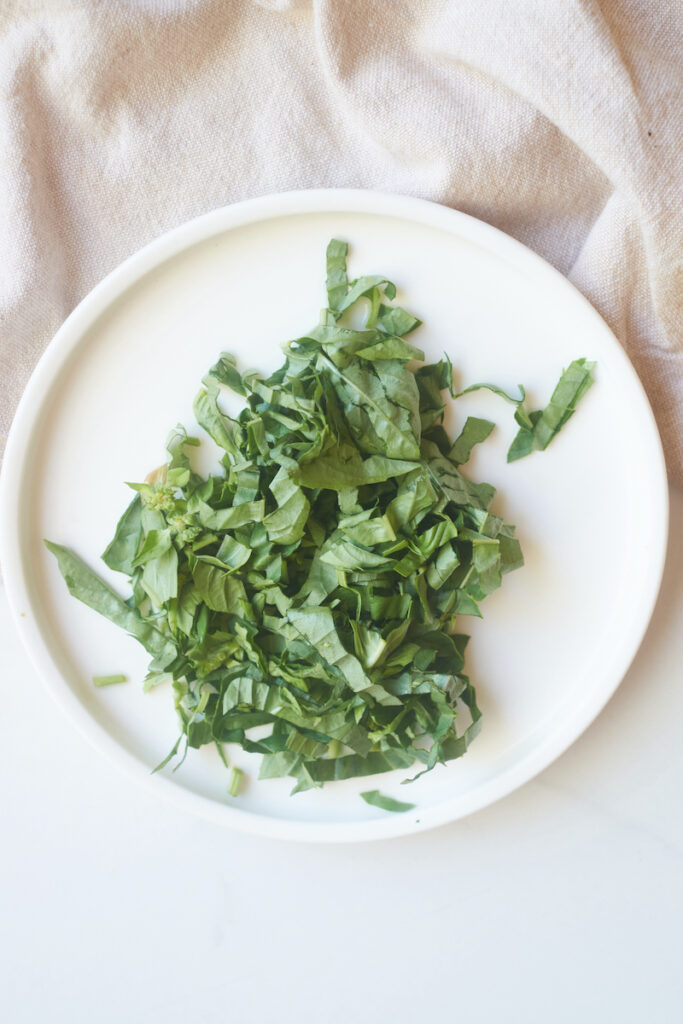
Because you only cut each part of the leaf once, it minimizes bruising and discoloration of the leaves.
To chiffonade the basil leaves, stack a few leaves on top of one another on a cutting board, placing the largest leaves at the bottom of the stack and the smallest leaves at the top.
Roll your stack of basil leaves as if you’re rolling a cigarette or cigar. Keeping the “cigar” tight, use a sharp knife to cut the basil cross-wise in really thin slices. Only cut once to reduce bruising, and cut the ribbons as thin as you can.
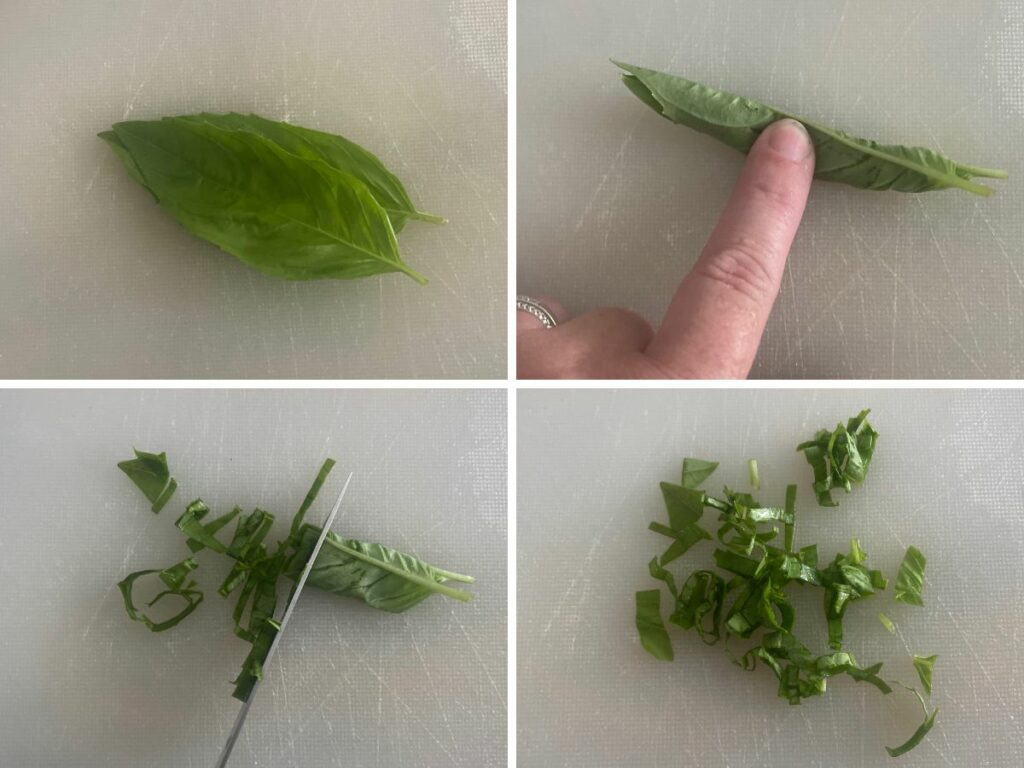
If you don’t want to chiffonade, you can also rough chop, but be warned: you may have to contend with some discoloration.
Once you’ve got your basil ribbons, evenly divide them amongst the compartments in an ice cube tray, gently pushing them down towards the bottom, so they are fairly compact.
Top up the compartments with room temperature broth (chicken or veggie) until the basil is covered with broth.
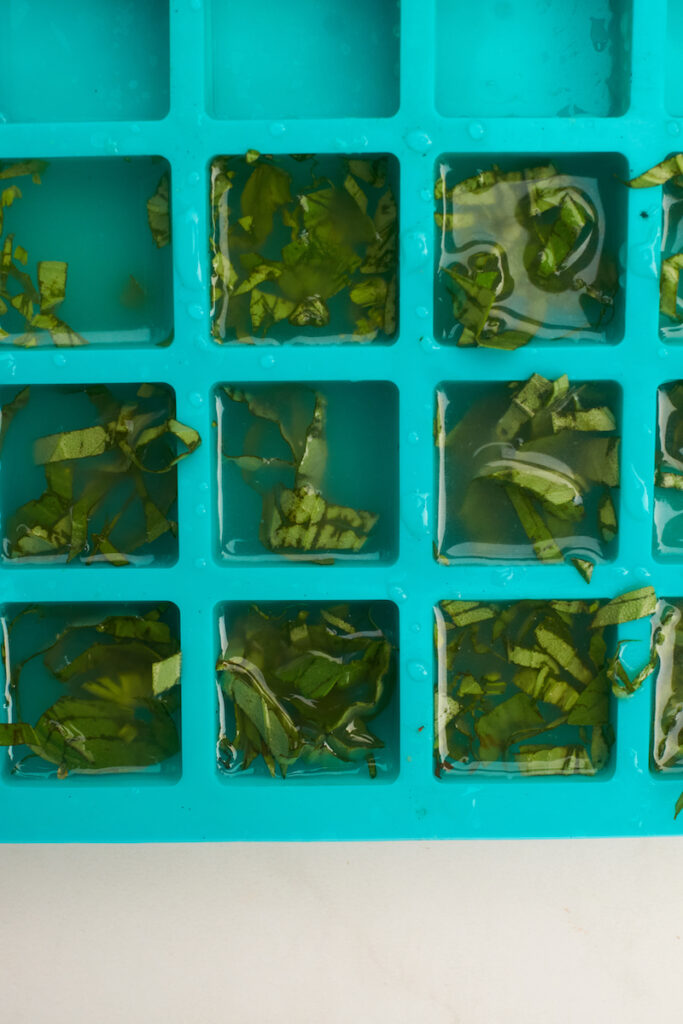
Let them freeze for 12 to 24 hours, and when completely frozen you can pop them out of the ice cube tray and store them in a ziplock freezer bag, or another airtight container.
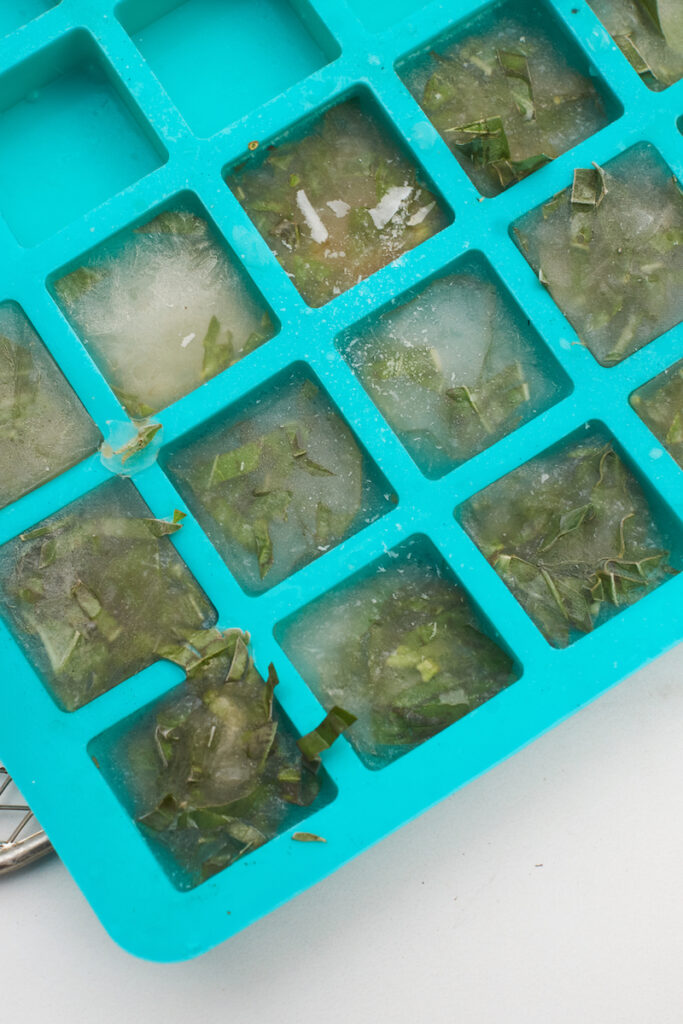
Method 3 – Straight into the Bag
Freezing whole basil leaves using this method is easy, works pretty well, and is great if you will need whole leaves for future recipes, without any extra stuff like broth or oil.
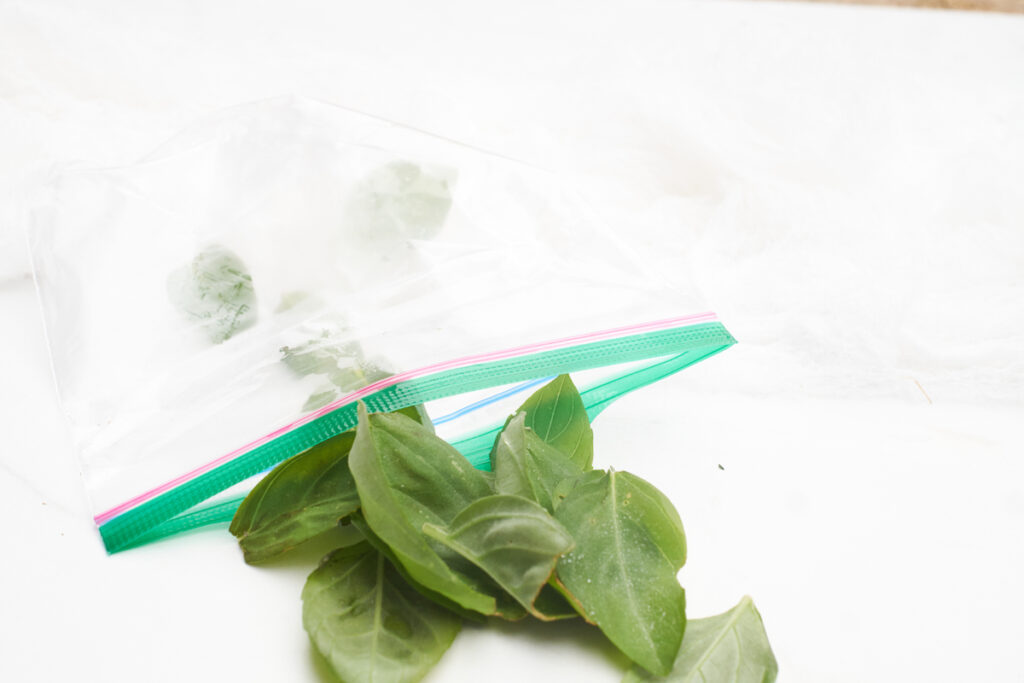
With this method, it’s extra important your basil leaves are nice and dry before you try freezing them. If there is still water on the leaves, they’ll be more likely to brown, more likely to get freezer burn, but they’ll also be more likely to get all stuck together.
Once you’re confident the leaves are dry, place them in a plastic bag, and try to remove as much air as possible before placing straight into the freezer.
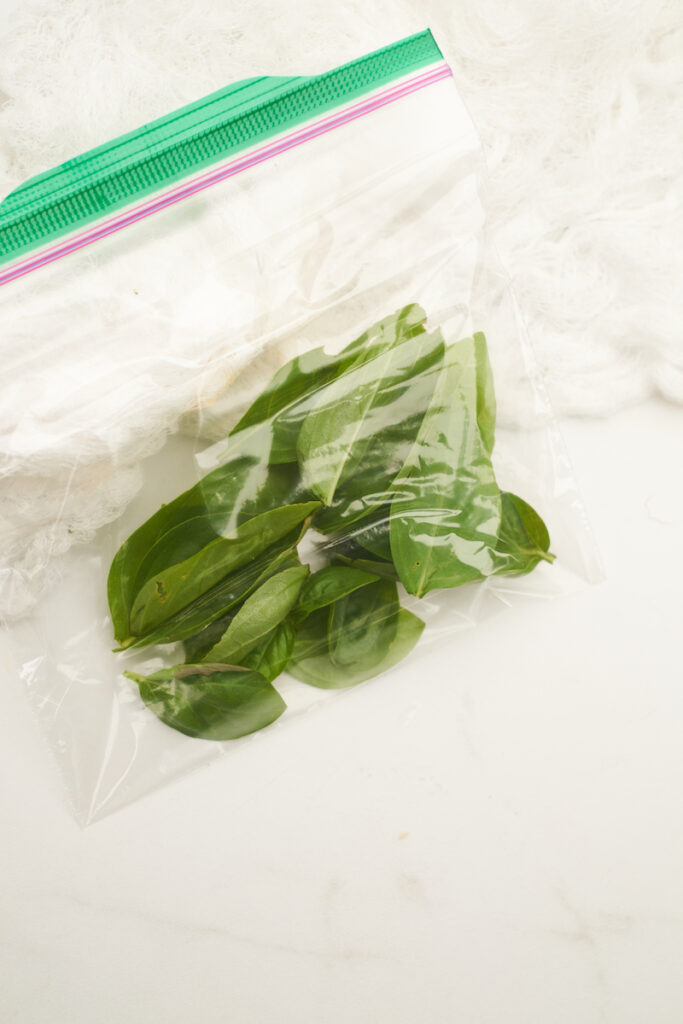
That’s all there is to this method. You’re done!
Method 4 – Flat Freeze Whole Basil Leaves (No Blanching)
Like the “straight into the bag” method, this way to freeze fresh basil is super simple, and works great when you want whole leaves. It also reduces the chance that the leaves will stick together (as with the straight into the bag method) if you don’t get all the moisture off.
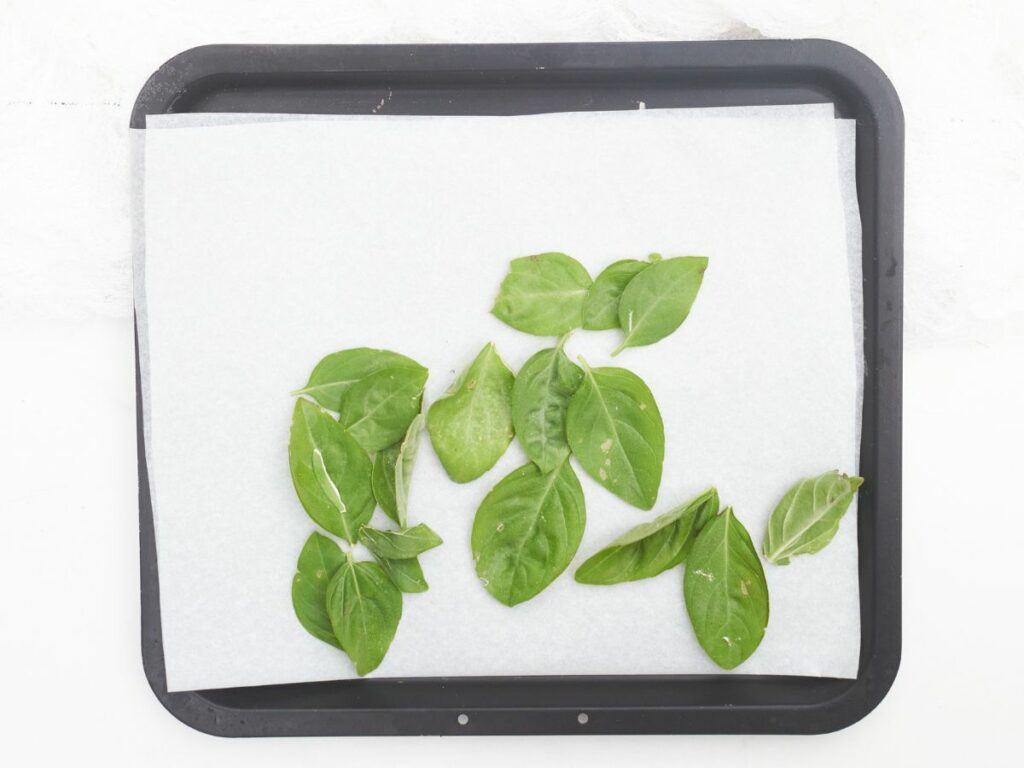
Once your basil leaves are washed and dried, place them on a baking sheet in a single layer.
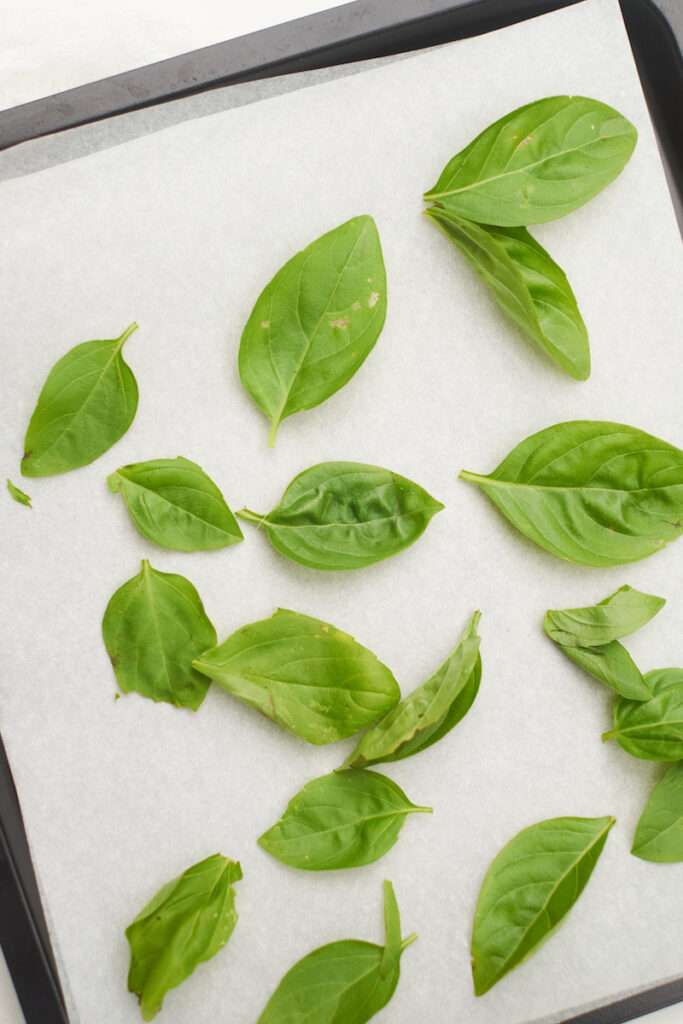
Put the tray with the basil leaves in your freezer, spaced out so they aren’t touching, and leave them for 12 to 24 hours, until totally firm and frozen.
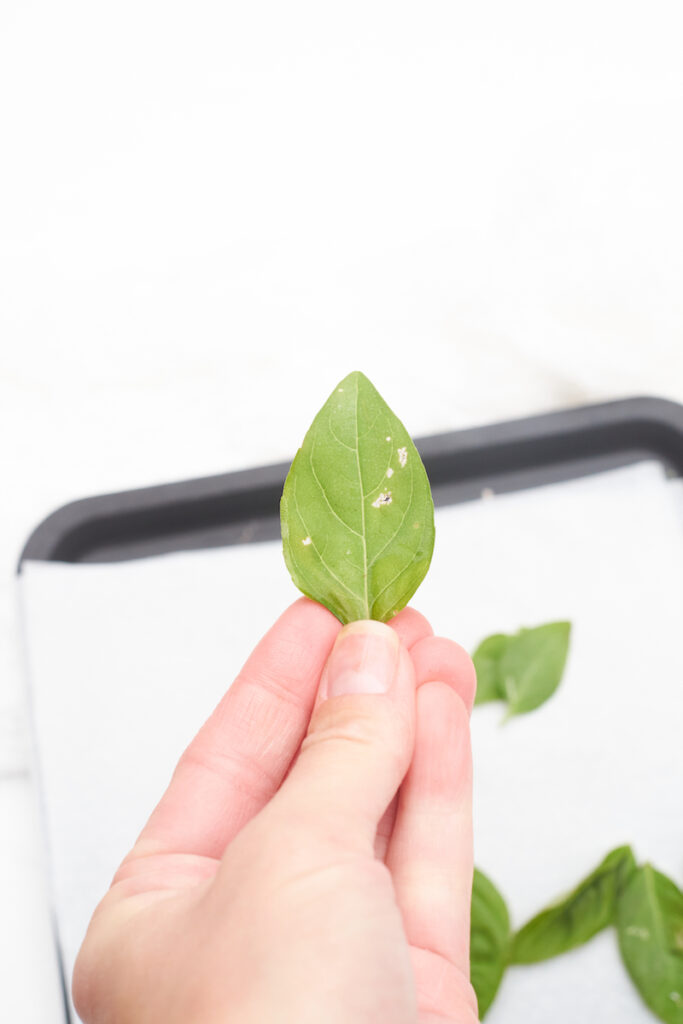
Once frozen, transfer from tray to ziplock bag. If you’re slow, they’ll start to thaw and turn brown at this point so work fast.
Method 5 – Blanch & Freeze Whole Basil Leaves
This method and the next one (blanched basil cigars) are by far the most complicated ways to freeze basil. This is also considered by some to be the gold standard method, but personally I don’t find the blanching worth it, and also find it extremely fussy. As you’ll see from the photos, my blanched basil turned black after freezing, and looks worse than the unblanched basil – not exactly a ringing endorsement for blanching.
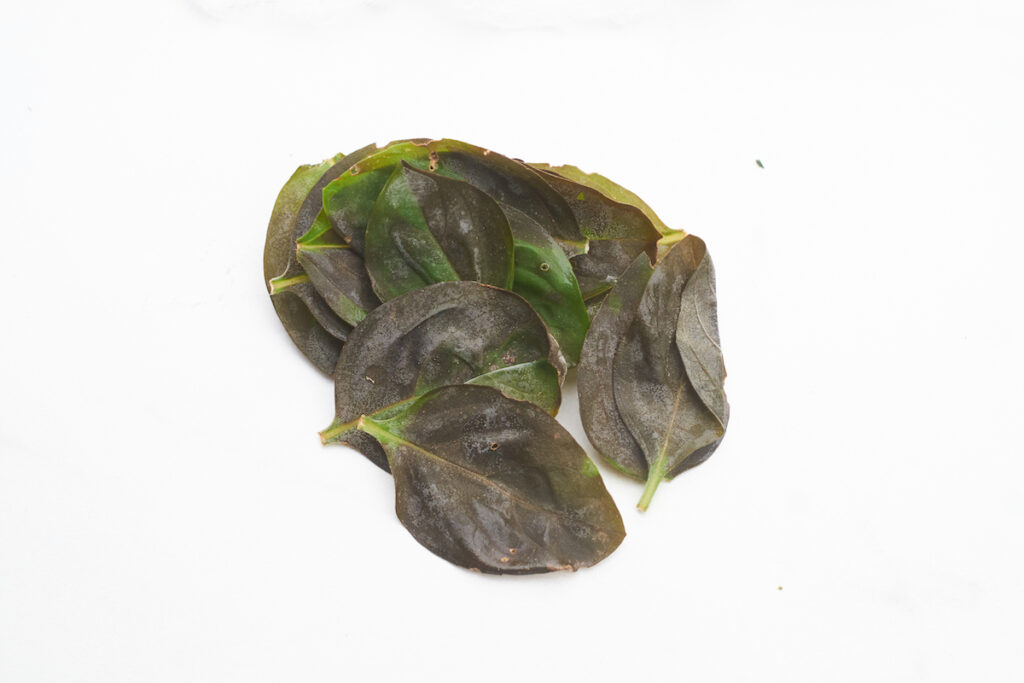
If you do want to try blanching your basil before freezing, here’s what you’ll need (in addition to the usual basil freezing supplies listed above):
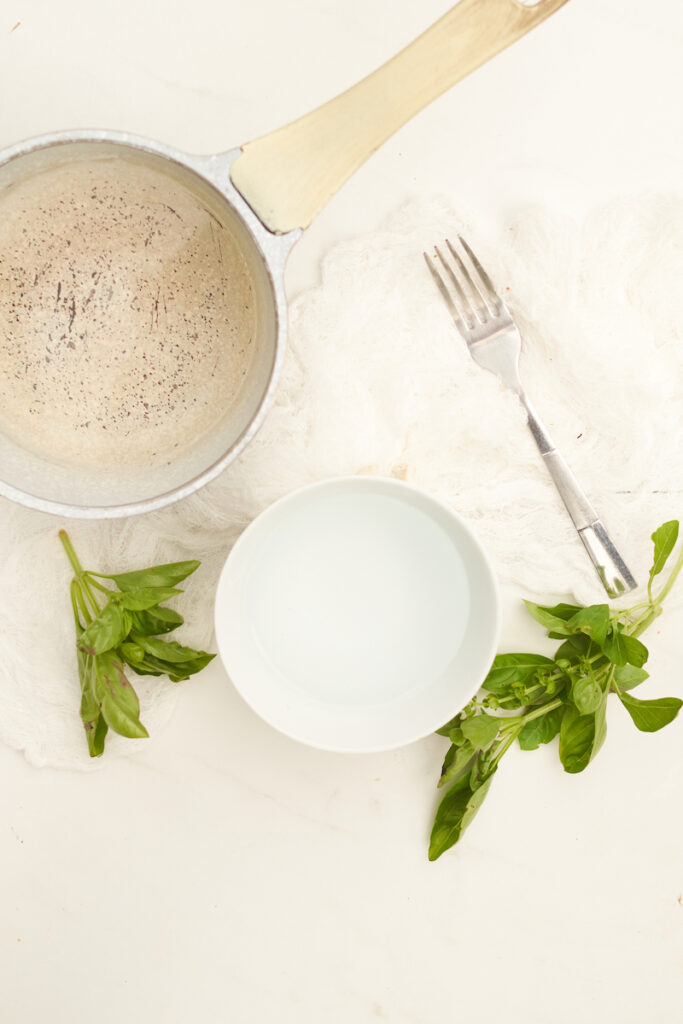
- Metal or silicone sieve or colander that’s safe for high heat
- 1 large pot that the sieve/colander can easily fit into
- 1 large bowl that the sieve/colander can easily fit into
- Ice cubes (several cups, to cool down water in the bowl)
- Salad Spinner (ideally)
- Cookie tray and parchment paper
When you’re ready to get started, bring a large pot of water to a rolling boil. While you wait for the water to boil, prepare your “cold bath” – a large bowl with cold water and lots of ice cubes (add the ice cubes when you’re almost ready for them, so they don’t melt too much).
Once the water is boiling and the ice bath is ready, add the fresh basil leaves into your heat safe sieve/colander, and then place it into the boiling water for 3 to 5 seconds. Any longer than 3 to 5 seconds, and the basil will start to turn brown (which is what happened with my basil in these photos), so the timing is important here to maintain the beautiful green color!


Remove the basil leaves and colander after 3 to 5 seconds and place them in the ice bath. This will stop the cooking.
Drain and dry the leaves as best you can, getting rid of excess moisture, and then lay out the leaves on a parchment lined cookie sheet and freeze until frozen through.
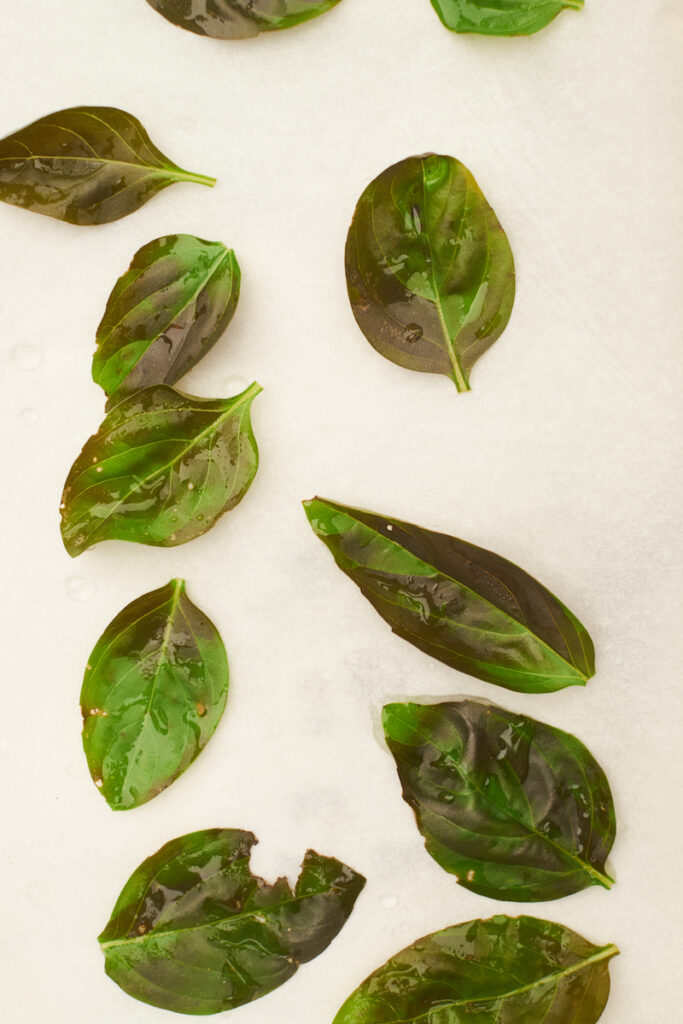
Transfer the leaves from the cookie sheet to an air tight container, working quickly as they will thaw fast.
Method 6 – Blanch and Store Basil Cigars
This final method uses blanched basil, as outlined above. Instead of flat freezing them, you can roll the blanched leaves into a little “basil cigar,” and then wrap them up to freeze. When it comes time to use them, cut in a chiffonade.
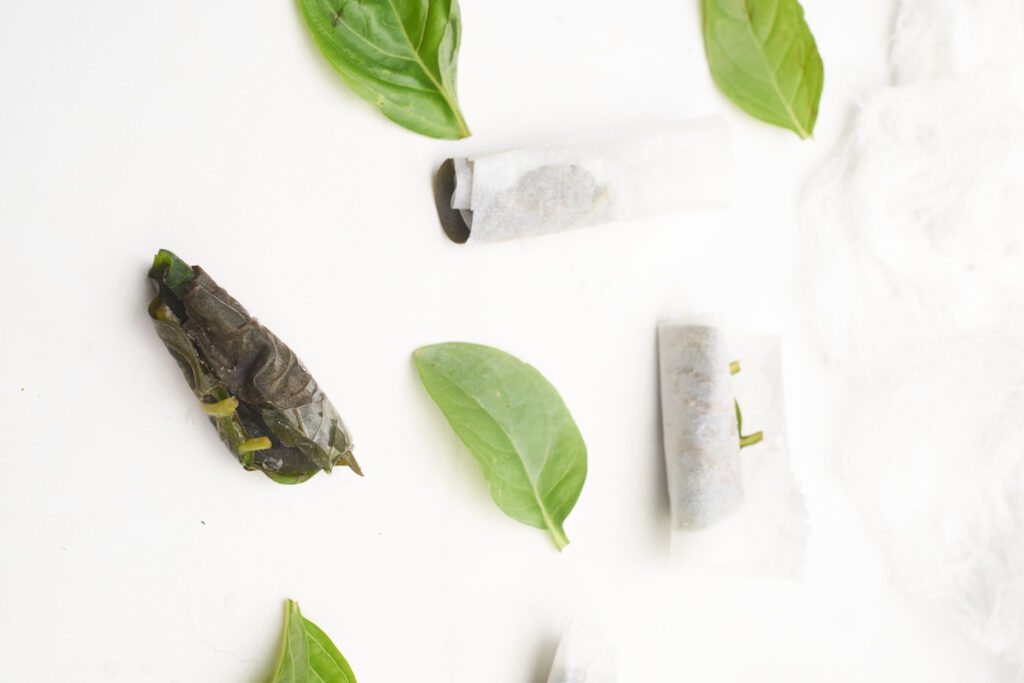
I find this method quite fussy, but if you want to try it, you go through the “blanch and ice bath” process as above, and then dry the leaves in a salad spinner/pat with paper towel as best you can.
Then stack several of the blanched and dried leaves biggest (bottom) to smallest (top) as if to chiffonade (see method 2 above), and roll into a cigar (again, similar to a chiffonade).
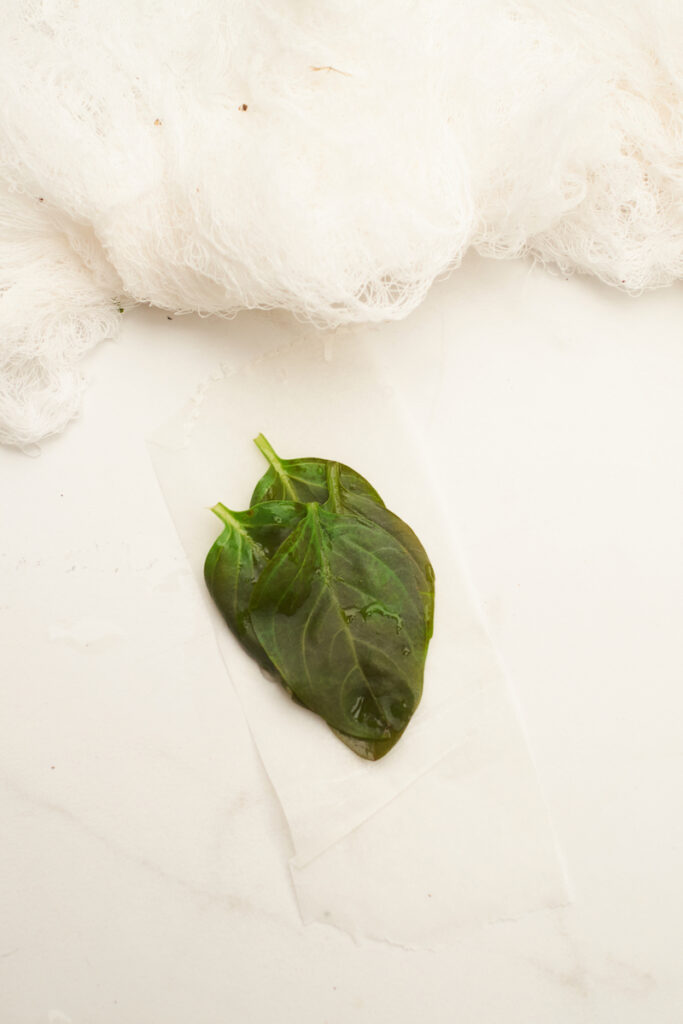
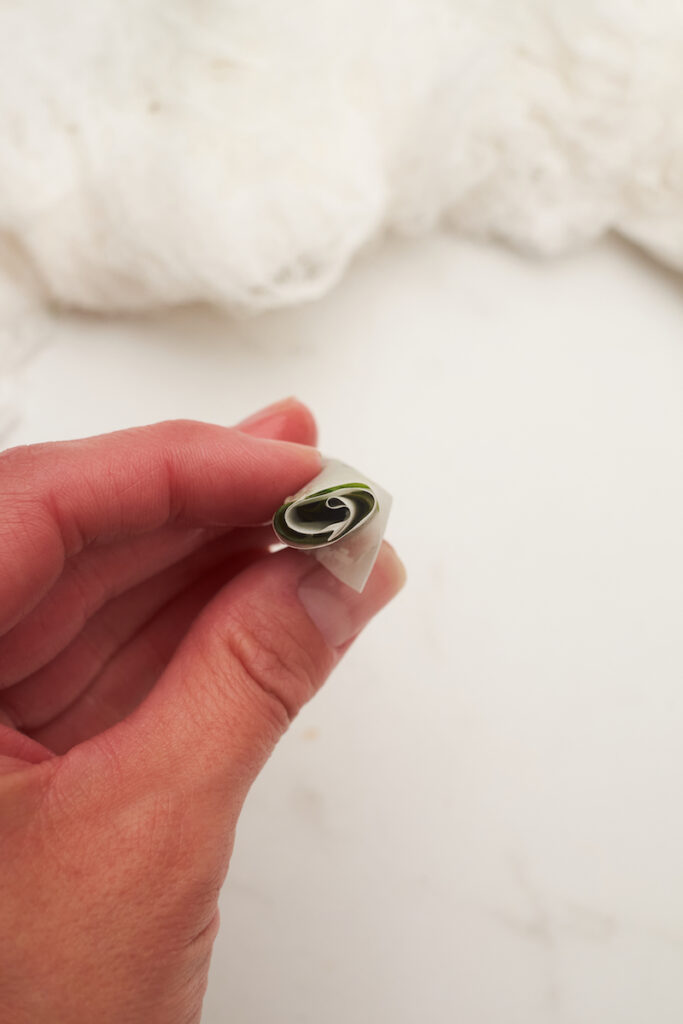
Wrap the cigar in a piece of wax paper (ideally), or plastic wrap (if you don’t have wax paper) and twist the ends to seal. Repeat until you have all the basil leaves into little cigars.
Freeze them in a bag, and when it comes time to use them, pull a little cigar out of the oven and cut them into ribbons like a chiffonade.
Final Thoughts
In my view, the basil freezing methods that don’t involve blanching are far superior, but to each their own!
How do you like to freeze your basil?

